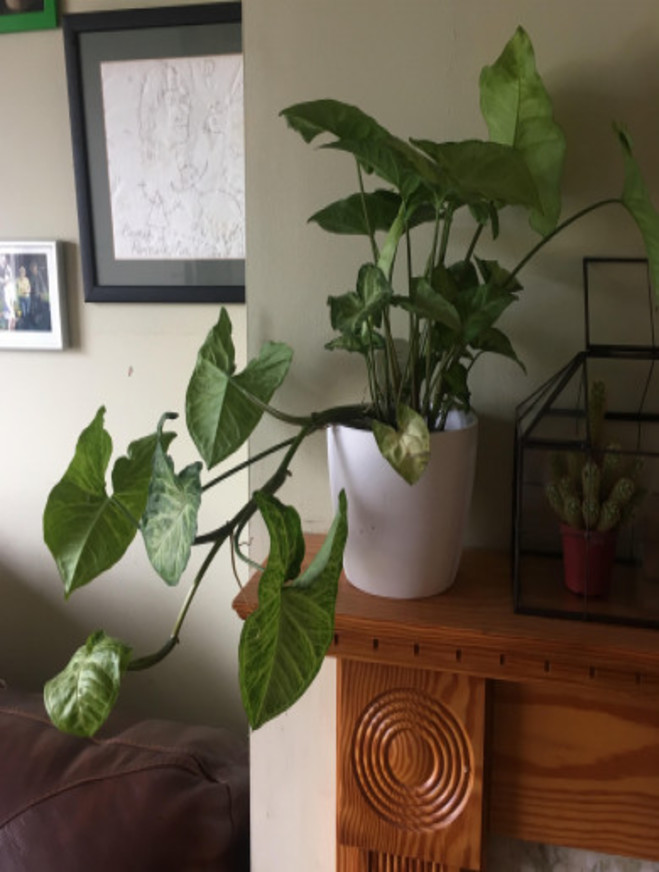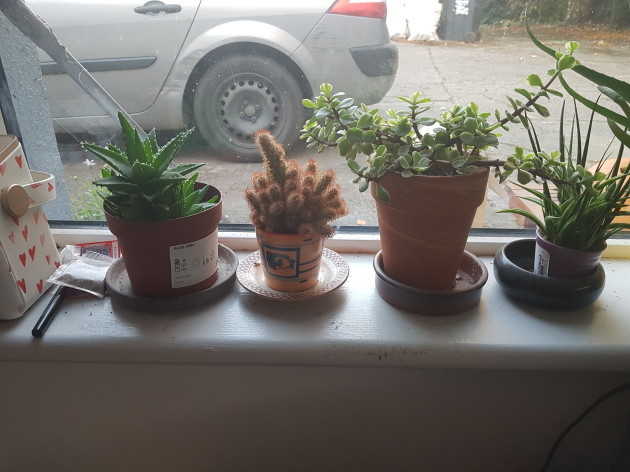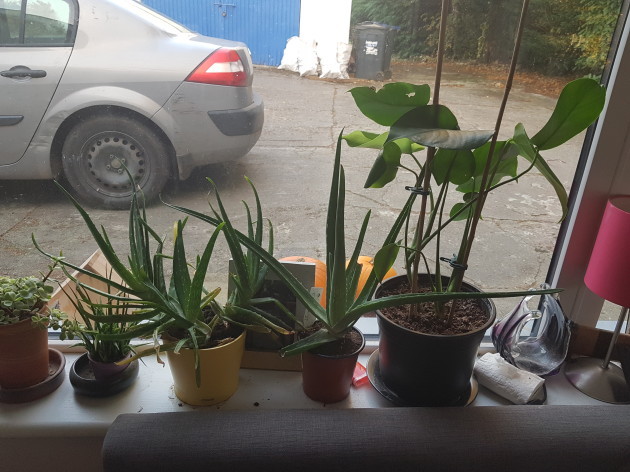AS I QUEUE for my matcha latte (notions) on my break from my work, I find myself drawn to something else for sale on the counter. Not protein balls, or pastries – rather, something potted.
Tiny succulents and cacti encircled the cash register, suddenly begging for me to take them home; to love them, nurture them. I hadn’t owned a plant since I was mistakenly given a basil plant by my Dad in college, tasked with the sole job of keeping the thing alive. If it was a test, I failed, after several months yo-yoing between under-watering and drowning the thing.
What made me think I was ready again? Well, after being giving a potted plot as a birthday present, (a great shout, in my opinion), that has a guaranteed minimum life expectancy of nine months, I felt confident enough to let some leafy lovin’ in to my life. (I mean, they just look so nice.)
As it turns out, I’m not the only one. More and more people my age seem to be turning to plants as a new outlet for destressing and creativity. ‘Gardening Twitter’ (and Instagram) are now sub genres all of their own, where people share their hints and tips on how to be the best parent for your plants. Europeans alone spent €36 billion on house plants and cut flowers last year.
Why did it become so trendy though? For the aesthetics or for the need to nurture?
While it may be super popular now to load up on Fila tops and cacti in Urban Outfitters, people have long been buying and keeping plants before Instagram was a thing.
“People have been keeping plants indoors for centuries,” says Rachel Freeman, horticulturalist and lecturer at Institue of Technology Blanchardstown. “If you look back at Roman and Greek civilisation, plants were kept for two reasons – partly aesthetic, but it would have started out as providing a source of food.
“Then, there was a move towards the aesthetic, and being a sign of wealth – if you could have plants, you were obviously wealthy.
The most significant thing for Ireland was the era of the Grand Tour. Around the 1700s, you got people travelling overseas going, “oh my God, I want Versailles in my back garden.”
Wardian cases – an early type of sealed protective container for plants bolted to ships – allowed the plants to be transported to wider Europe. The people who sought them out, notably referred to as ‘plant hunters’, were sponsored by royal descendants to bring back new, exotic plants.
“Fast forward to the late sixties/early seventies, NASA were doing a lot of trials on how they could sustain life off of earth,” Rachel explains. “Bill Wolverton did a lot of studies on cleaning air and cleaning water for indoor environments, and he focused very much on plants.
Out of that, he realised that some plants were very good at doing both.”
It’s very much impacted how and why we keep plants today, as Rachel further explains.
“Urban living, distancing ourselves from nature … We’ve started to realise that a lot of this is bad for us. People are going back to Wolverton’s study – keeping plants is one way we can include nature in our lives and green our environment.
“There’s a huge movement at the minute focusing on natural health and alternative treatment. We need to be close to a natural environment, and if not, we need to mimic in it some way.”
Meet the (plant) parents
“Ever since I was a toddler I’ve been obsessed with Victorian aesthetics; botanic gardens, things in big glass cases like greenhouses, fern boxes, the architecture of natural history museums,” Hollie, a Dublin-based illustrator tells DailyEdge.ie.
I basically want to live in a greenhouse, which is kind of what my house is quickly morphing into.
As a child, she tended to her own ‘grasshead’ – essentially, a sack of earth and seeds with a face on it.
“You water it and grass starts growing from the head, except my grasshead came with a healthy dose of tropical wasp eggs which infested the apartment we were living in at the time.
They had to call exterminators and my grasshead was binned. I’m really surprised that didn’t completely turn me off plants to be honest.”
Luckily, it didn’t and she now has a collection worth coveting, including some baby areca palms, a few fig trees, Crispy Waves, a Mother-in-law’s Tongue, (an actual plant, just FYI), carnivorous plants, succulents, ferns, a Monstera, a string-of-hearts, a string-of-pearls, a Pilea Raindrop and some cacti.
“And they’re just my indoor plants!” she says.
“I try to get my plants from small, independent plant suppliers like Urban Plant Life on Cork St, but I find it hard to pass by a plant wherever they’re sold. Lidl & Aldi generally do good seasonal selections of healthy leafy lads. Johnstown Garden Centre is a dreamland and supply everything from Monkey-Mask Monsteras to Buddha’s Temples.”
Katie, a parish secretary from Bunclody, Co. Waterford, remembers always having plants in the house, but none that she could call her own. Now, she has nine in one room.
“One of them is an aloe of some description but not an Aloe Vera,” she tells DailyEdge.ie. “I also have a generic little cactus. I have what I think is an Elephant’s Foot jade plant, but I’m honestly not sure, I just know it’s a succulent.
“Then there’s a weird spiky plant I got in IKEA and I have genuinely no idea what it is. It looks like plastic and you would think it was if it didn’t grow! I have two Aloe Vera plants, a baby Monstera – he doesn’t have any split leaves yet – a spider plant, and an orchid.
They all have names because I’m a child and name my plants.”
What’s prompted the passion for plants among of this generation? Hollie’s answer is a familar one.
“This is probably mad depressing but I think it’s because the majority of people in their 20s-40s are renting and it’s fairly impossible to decorate,” she says.
“We’re very much of an instant generation,” Rachel says, acknowledging the impact social media has had when it comes to increased plant ownership. “We want people to know what we’re about.
“Alongside of that, culturally, we have changed. Millenials – I hate to say it – are not settling down as quickly as other generations did, and they’re not buying houses.
Our parents would have bought a house, and they would have done the garden, put down some shrubs, an apple tree, maybe some veg … This current generation, at the same age, aren’t able to do that, but have that inherent need to nurture something.”
Katie is of a similar mind: “I know myself anyway I like to have plants because they make me happy. I like to watch them grow.
“I like to mind them, though I specifically choose low maintenance plants like succulents and cacti for the most part.
Like, my Monstera, he’s grown so many new leaves and roots since I got him and it’s pretty awesome to know that that’s because of me? They’re like super low responsibility pets really.
“But I think owning any plant has an appeal to most people,” she adds. “When you have something like an orchid – which we are terrible at keeping, we’re on our third or something like that because people keep giving them to my aunt as a gift -we just don’t know how to care for them. But this one has thrived. It doesn’t have any leaves at the moment but it’s not dead.
We can see it growing itself and getting bigger and stronger and it’s just awesome? It’s a just great knowing you didn’t kill it.”
Beyond the home, people are also bringing their plants to work, per se, by creating their own little desk oasis. (Hollie works from home, but is looking forward to renting a studio space “so I can work around other human beings and … Have room for more plants”.)
All of Katie’s plants, which she’s purchased from an array of places, currently reside at her house. She is considering greening up her office space though.
“My office is really warm but most of my plants are succulents so they wouldn’t mind too much,” she says. “I used to have the little cactus in my dorm room in Dublin when I was studying (or more accurately not studying) up there a few years ago because I felt like my room needed a plant.”
Killing in the name of
People have managed to write entire books on how not to kill plants. It seems to be the main thing that puts people off starting a plant collection. However, even the most keen gardener can fall victim to the heavy hand of the overly-enthusiastic watering can.
Rachel puts plant death down to two main things – under-watering and over-watering (yes, it’s a thing.)
“People tend to kill them with kindness,” she explains. “Letting them dry out in and out of clean water is a good idea. Beyond that, knowing when to pot them on and being on the look out for pests and disease … The only thing I would say is, if you buy well and maintain them well, you generally don’t get then. Plants under stress suffer from pests and disease.
Garlic spray is the best thing ever invented when it comes to treating pests and disease in plants.”
“I actually binned my first Monstera because I thought he was dead beyond resurrection,” Hollie says. “I repotted it, which makes them very angry, which I didn’t know at the time.
When they’re angry they start to shrivel up and the leaves turn brown, but they return to normal after a week or two. However, the bins had been collected by then.
She also recalls a time when she lost a plant to the hands of her own grandmother. “My grandma was watering my maidenhead fern while I was away last year but accidentally sprayed it with bleach. She tried to save it by putting it in the sink and rinsing a la washing a babby’s hair.
Another time she was taking care of a carnivorous plant of mine while I was doing my J1 in NY, she was afraid it wasn’t getting enough flies to eat so would put it into the compost bin for an hour or two each day.
“She takes care of my plants as if they’re my children, she’s an angel,” she says.
Katie says: “I’ve had 2 plants die and one plant nearly die twice. The first one was actually the father of one of my current plants. I had it for like a year and then it just started to rot. I honestly have no idea what happened, I hadn’t watered it too much or too little. I’m still confused about it. It just got really gross and then I had to dump it.
“The other was a Venus Fly Trap which are just tricky plants to keep because they don’t really like water that has anything added in to it, so tap water just sort of killed mine.
“And then the third one is the aloe I have. It grew like mad and needed to have it’s babies taken out of it’s pot so it had more space. And then it never really bounced back from the repotting. So eventually I just sort of called it a lost cause and bought a second one. And now of course it’s doing okay, so I’m left with two aloes … We’ll see what happens there.”
So you’re having a plant baby …
If you’re looking to jump on the succulent-laden bandwagon, here’s some advice from the people who’ve done it.
“Start with succulents, cacti and palms,” Hollie says. “Stay away from ferns if you’re a beginner unless it’s a particularly hardy boy. Ferns are so hard to keep alive.
“For a gift, I would recommend a Begonia Maculata, which is probably incredible bad advice because I don’t even own one myself as I have yet to find a local plant shop that sells them, but they are so cool and pretty.”
According to Rachel, the garden centre should be your first port of call.
“If you’re thinking of keeping plants, it’s worth your while spending that extra couple of quid at the garden centre. You’re going to get really good advice from someone who knows what they’re talking about.
“If you happen to be buying from Aldi and Lidl, you’d want to be buying them on the day.”
Katie reckons the only thing people need to do is stay simple.
“Buy something cheap and cheerful that makes your heart happy from somewhere, see what the instructions are and then just do your best with it.
If it dies that sucks but plants are replaceable! If it doesn’t die then you’ll have a little plant buddy for who knows how long.”





